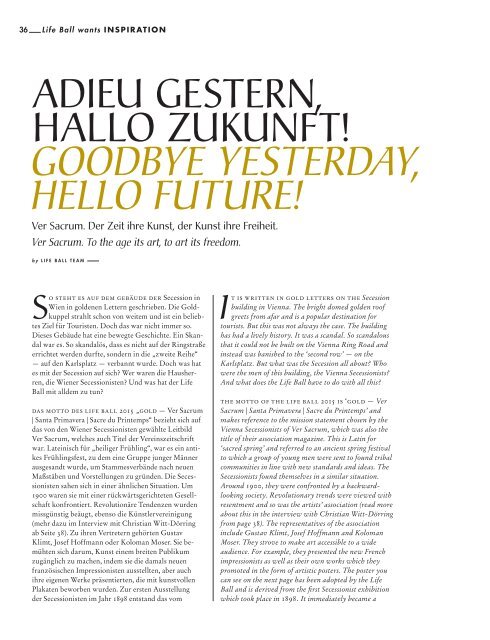You also want an ePaper? Increase the reach of your titles
YUMPU automatically turns print PDFs into web optimized ePapers that Google loves.
36 <strong>Life</strong> <strong>Ball</strong> wants inspiration<br />
adieu gestern,<br />
hallo zukunft!<br />
goodbye yesterday,<br />
hello future!<br />
Ver Sacrum. Der Zeit ihre Kunst, der Kunst ihre Freiheit.<br />
Ver Sacrum. To the age its art, to art its freedom.<br />
by LIFE BALL TEAM<br />
So steht es auf dem gebäude der Secession in<br />
Wien in goldenen Lettern geschrieben. Die Goldkuppel<br />
strahlt schon von weitem und ist ein beliebtes<br />
Ziel für Touristen. Doch das war nicht immer so.<br />
Dieses Gebäude hat eine bewegte Geschichte. Ein Skandal<br />
war es. So skandalös, dass es nicht auf der Ringstraße<br />
errichtet werden durfte, sondern in die „zweite Reihe“<br />
— auf den Karlsplatz — verbannt wurde. Doch was hat<br />
es mit der Secession auf sich? Wer waren die Hausherren,<br />
die Wiener Secessionisten? Und was hat der <strong>Life</strong><br />
<strong>Ball</strong> mit alldem zu tun?<br />
das motto des life ball <strong>2015</strong> „gold — Ver Sacrum<br />
| Santa Primavera | Sacre du Printemps“ bezieht sich auf<br />
das von den Wiener Secessionisten gewählte Leitbild<br />
Ver Sacrum, welches auch Titel der Vereinszeitschrift<br />
war. Lateinisch für „heiliger Frühling“, war es ein antikes<br />
Frühlingsfest, zu dem eine Gruppe junger Männer<br />
ausgesandt wurde, um Stammesverbände nach neuen<br />
Maßstäben und Vorstellungen zu gründen. Die Secessionisten<br />
sahen sich in einer ähnlichen Situation. Um<br />
1900 waren sie mit einer rückwärtsgerichteten Gesellschaft<br />
konfrontiert. Revolutionäre Tendenzen wurden<br />
missgünstig beäugt, ebenso die Künstlervereinigung<br />
(mehr dazu im Interview mit Christian Witt-Dörring<br />
ab Seite 38). Zu ihren Vertretern gehörten Gustav<br />
Klimt, Josef Hoffmann oder Koloman Moser. Sie bemühten<br />
sich darum, Kunst einem breiten Publikum<br />
zugänglich zu machen, indem sie die damals neuen<br />
französischen Impressionisten ausstellten, aber auch<br />
ihre eigenen Werke präsentierten, die mit kunstvollen<br />
Plakaten beworben wurden. Zur ersten Ausstellung<br />
der Secessionisten im Jahr 1898 entstand das vom<br />
It is written in gold letters on the Secession<br />
building in Vienna. The bright domed golden roof<br />
greets from afar and is a popular destination for<br />
tourists. But this was not always the case. The building<br />
has had a lively history. It was a scandal. So scandalous<br />
that it could not be built on the Vienna Ring Road and<br />
instead was banished to the ‘second row’ — on the<br />
Karls platz. But what was the Secession all about? Who<br />
were the men of this building, the Vienna Secessionists?<br />
And what does the <strong>Life</strong> <strong>Ball</strong> have to do with all this?<br />
the motto of the life ball <strong>2015</strong> is ‘gold — Ver<br />
Sacrum | Santa Primavera | Sacre du Printemps’ and<br />
makes reference to the mission statement chosen by the<br />
Vienna Secessionists of Ver Sacrum, which was also the<br />
title of their association magazine. This is Latin for<br />
‘sacred spring’ and referred to an ancient spring festival<br />
to which a group of young men were sent to found tribal<br />
communities in line with new standards and ideas. The<br />
Secessionists found themselves in a similar situation.<br />
Around 1900, they were confronted by a backwardlooking<br />
society. Revolutionary trends were viewed with<br />
resentment and so was the artists’ asso ciation (read more<br />
about this in the interview with Christian Witt-Dörring<br />
from page 38). The represent atives of the association<br />
include Gustav Klimt, Josef Hoffmann and Koloman<br />
Moser. They strove to make art accessible to a wide<br />
audience. For example, they presented the new French<br />
impressionists as well as their own works which they<br />
promoted in the form of artistic posters. The poster you<br />
can see on the next page has been adopted by the <strong>Life</strong><br />
<strong>Ball</strong> and is derived from the first Secessionist exhibition<br />
which took place in 1898. It immediately became a


